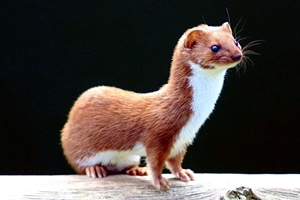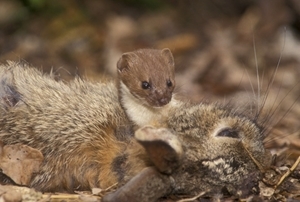Weasel
 The smallest carnivore on earth, the weasel (Mustela nivalis), pound for pound has a higher bite force than a lion, tiger or polar bear, which for their body size is very impressive and makes it one of the most unparalleled predators on the planet!
The smallest carnivore on earth, the weasel (Mustela nivalis), pound for pound has a higher bite force than a lion, tiger or polar bear, which for their body size is very impressive and makes it one of the most unparalleled predators on the planet!
What they lack in size, weasels make up in tenacity and appetite, eating a third of their own body weight daily. They have a varied diet of voles and mice being their primary prey, and by using their size to their advantage, they can follow rodents in hot pursuit down into their underground burrows. They also can take larger prey, such as young rabbits, and will readily hunt birds and take their eggs too.
The weasel is the UK’s smallest member of the order Carnivora, which also includes cats, dogs and bears. The largest member, the polar bear, can weigh more than 5,000 weasels combined!
They belong to a group of animals known as mustelids, one of the most varied animal groups in the world with 65 species (which include stoats, badgers, otters, ferrets, martens, mink, honey badgers, giant otters and wolverines, among others) found from the Arctic to the tropics. These long-bodied and short-legged predators are not much bigger than the mice and voles they eat, typically measuring just 20-27cm long. Even the largest male weasel is unlikely to weigh more than 195g, while a small female may be just 50g.
According to rural folklore, some weasels are small enough to squeeze through a wedding ring.
The age-old question...
Q. What's the difference between a stoat and weasel?
A. A weasel is weasily wecognised and a stoat is stoatally different.
Weasels are native to Britain and have chestnut brown fur with white-cream underparts and a long, slim body that ends in a short tail. Not to be confused with the stoat, which is larger and has a longer tail that ends in a bushy black tip. Weasel tails are always wholly brown. So, if you see a small brown blur running rapidly between cover, it is most likely to be a weasel!
Weasels are solitary and only come together to mate, and they are quite different in their reproductive habits to stoats. This is probably due to the shorter life that weasels lead, with a lifespan of approximately only two years, forcing them to produce offspring as quickly as possible. They can produce two litters a year of around four to six young at a time, known as kits, which are born between April and August. The young are normally raised in a nest or den taken over from the weasel’s rodent prey, and weaning occurs after three to four weeks with the kits independent in two to three months, by which time they are already able hunters.
 So, where can you find these powerful little hunters? They can be found throughout Britain but are absent from Ireland, and can survive in lots of different habitats including woodland, farmland, grassland and moorland, provided there is plenty of prey to eat and cover to provide shelter from larger predators. They are very elusive and rarely spend much time in the open, instead hunting under the cover of long grass and other vegetation and making use of linear features such as hedgerows and drystone walls to move around their territory, keeping well-hidden most of the time.
So, where can you find these powerful little hunters? They can be found throughout Britain but are absent from Ireland, and can survive in lots of different habitats including woodland, farmland, grassland and moorland, provided there is plenty of prey to eat and cover to provide shelter from larger predators. They are very elusive and rarely spend much time in the open, instead hunting under the cover of long grass and other vegetation and making use of linear features such as hedgerows and drystone walls to move around their territory, keeping well-hidden most of the time.
Because of this they are rarely seen – most sightings are simply chance encounters.
In my lifetime, I have had the pleasure of seeing quite a few weasels, either while out doing surveys on the Farmer Clusters, or while on a walk, but more so while driving as they dart across the road like a flash of brown lightning. One of my most treasured encounters was stopping on a bike ride through my village a few years ago as I could hear lots of squealing going on in the hedgerow, and as I stood still, holding my bike up, I looked down and five young kits came flying out of the hedge, running around my feet, chasing each other and not caring a jot that I was there!
So do keep your eyes peeled on your next woodland walk or drive down a country lane. You may be lucky enough to see one dart across your path in search of its next meal!
Finally, I just wanted to add this little gem. Pete Thompson wrote about the stoat in the GWCT Species of the Month back in 2014 and he added the fabulous and interesting meaning behind the nursery rhyme Pop Goes the Weasel, so I thought I’d add it again in case you missed it.
In Cockney rhyming slang, weasel and stoat means coat, and if you popped something, you pawned it. What used to happen was that Cockneys frequently went into the Eagle pub, situated on the corner of Shepherdess Street and City Road, in the Shoreditch area of London. Many a good “session” was had, and they often spent far too much money enjoying themselves – so much so that they then had to go down to the pawnshop to literally hand over the coat off their backs! The pub still has a wall plaque telling you all about it. This is how the third verse goes:
Up and down the City Road,
In and out the Eagle,
That's the way the money goes;
Pop! goes the weasel
Love them or hate them, they are an incredible little mammal and one of my favourite species. One thing is for sure: you’ll never sing Pop Goes the Weasel again without thinking of selling the coat off your back!
Megan Lock
Advisory
Photo credit: Keven Law, David Mason